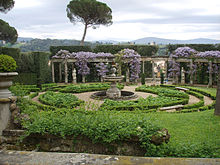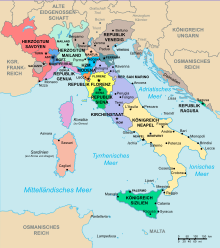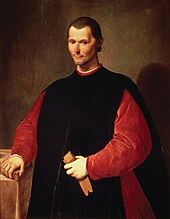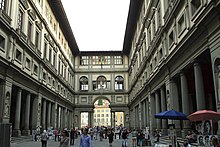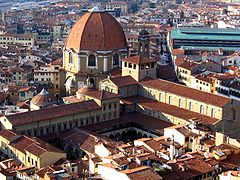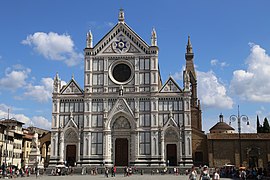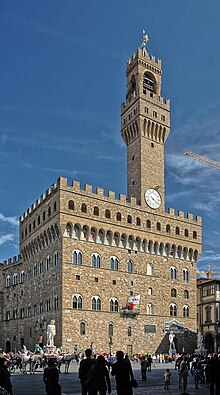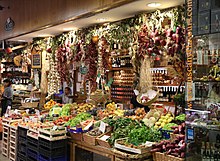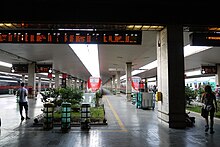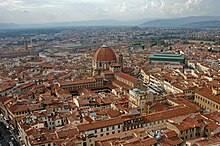Florence
| Firenze Florence |
||
|---|---|---|

|
|
|
| Country | Italy | |
| region | Tuscany | |
| Metropolitan city | Florence (FI) | |
| Coordinates | 43 ° 47 ' N , 11 ° 15' E | |
| height | 50 m slm | |
| surface | 102 km² | |
| Residents | 372,038 (Dec. 31, 2019) | |
| Population density | 3,647 inhabitants / km² | |
| Post Code | 50121-50145 | |
| prefix | 055 | |
| ISTAT number | 048017 | |
| Popular name | Florentine (Fiorentini) | |
| Patron saint |
John the Baptist (June 24th) |
|
| Website | comune.fi.it | |
 Clockwise from above: Cathedral of Santa Maria del Fiore , Piazza della Repubblica , Palazzo Pitti , Ponte Vecchio , Palazzo Vecchio and Michelangelo's David in the Accademia di Belle Arti |
||
Florence ( Italian Firenze [fiˈrεnʦe] ) is a major Italian city with 372,038 inhabitants (as of December 31, 2019). Around one million people live in the metropolitan area. Florence is the capital and largest city of Tuscany and the metropolitan city of Florence . In Italy, Florence is the eighth largest city by population .
Florence is famous for its history. As the center of late medieval European trade and finance, it was one of the richest cities of the 15th and 16th centuries. Florence is considered the cradle of the Renaissance . Due to its cultural importance - especially for the visual arts - it was also referred to as the "Italian Athens " in the 19th century .
The powerful Medici dynasty made Florence one of the most prosperous metropolises in Europe during the Renaissance. Numerous artists and clergy were at home here: Leonardo da Vinci spent large parts of his youth in Florence, Michelangelo found refuge in the Medici Church, and Galileo Galilei lived as court mathematician in the Medici palaces. From 1865 to 1870 the city was the capital of the newly established Kingdom of Italy .
The historic center of Florence attracts millions of tourists year after year. Euromonitor International placed the city in 40th place among the most visited cities worldwide with almost 4.2 million visitors in 2015. The historic city center was declared a World Heritage Site by UNESCO in 1982 . Forbes Magazine has selected Florence as one of the most beautiful cities in the world for its artistic and architectural heritage . Particular attention is drawn to the wealth of museums, palaces and monuments.
geography
Florence lies on the Arno , which flows through the old town, and on the Mugnone , which flows into the Arno from the north west of the old town. Coming from the south, the Ema joins the Greve near Galluzzo, then together they flow into the Arno in the city of Florence. The Arno was just as important for the supply of the people through trade, but caused destruction and suffering through flooding. The ridge of the Tuscan- Emilian Apennines extends north of Florence, and the Chianti hills border the city in the south .
View of Florence from Piazzale Michelangelo
Population development
The city's rise from an army camp to a Renaissance stronghold was slow. In 1330 the city had about 30,000 inhabitants. By 1348 the number of inhabitants grew to up to 100,000. The plague pandemic hit Florence particularly hard and claimed an estimated 70,000 deaths in Florence, with just under a fifth of the population surviving.
In the middle of the 19th century there was a continuous increase again, the city had 150,000 inhabitants. In the 1980s there were strong emigration flows and declines in the birth rate, which is why the number of inhabitants in Florence has been declining since then.
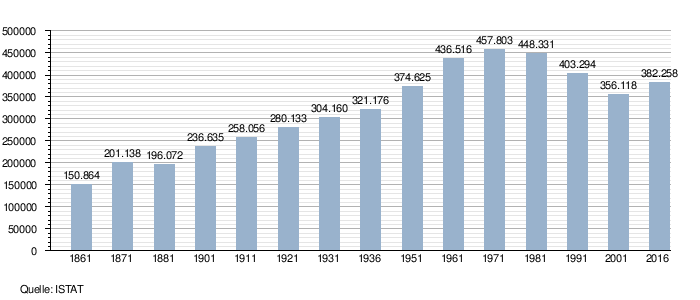
climate
Florence is still in the temperate climate zone with very warm summers and cold and humid winters. Due to its location and the associated lack of ventilation, it is noticeably warmer in Florence in summer than on the coast.
The highest recorded temperature was 44 ° C in July 1983. The lowest recorded temperature was −23 ° C in January 1985.
| Florence | ||||||||||||||||||||||||||||||||||||||||||||||||
|---|---|---|---|---|---|---|---|---|---|---|---|---|---|---|---|---|---|---|---|---|---|---|---|---|---|---|---|---|---|---|---|---|---|---|---|---|---|---|---|---|---|---|---|---|---|---|---|---|
| Climate diagram | ||||||||||||||||||||||||||||||||||||||||||||||||
| ||||||||||||||||||||||||||||||||||||||||||||||||
|
Average monthly temperatures and rainfall for Florence
Source: WMO
|
|||||||||||||||||||||||||||||||||||||||||||||||||||||||||||||||||||||||||||||||||||||||||||||||||||||||||
City structure
In the Middle Ages Florence was divided into four districts (Quartieri) , which were named after the city gates: San Piero, Duomo or Vescovo, San Pancrazio and Santa Maria. Later it became six so-called Sestieri: San Piero, Duomo, San Pancrazio, San Piero a Scheraggio, Borgo, Oltrarno. In addition, there are the suburbs to the west and east of the arterial roads and the striking hills of San Miniato, Belvedere and Bellosguardo in the south and Careggi, Montughi, Fiesole and Settignano in the north.
The modern administrative division into five city quarters from 1990 is based on the outside area on the boundaries of the traditional city quarters:
The five modern administrative units at a glance, with associated districts:
politics
Mayor (ital. Sindaco) of Florence is Dario Nardella, member of the PD ( Partito Democratico ) since May 26th 2014 . The former Prime Minister of Italy Matteo Renzi was the city's mayor from 2009 to 2014.
education
The University of Florence , founded in 1321, is centrally located, the European University Institute in Fiesole , which also houses the centers for Renaissance studies of Harvard University (Villa I Tatti), New York University (Villa La Pietra) and Georgetown University (Villa Le Balze) . The Accademia di Belle Arti is one of the oldest European art schools . Furthermore, the second seat of the elite university Scuola Normale Superiore is located in Florence next to Pisa.
history
The history of Florence today is u. a. So well known because it was first written down around 1520 by Niccolò Machiavelli (1469–1527). Machiavelli wrote his Istorie fiorentine on behalf of the Medici and in 1525 presented the extensive work to Giulio de 'Medici, also known as Pope Clement VII. Machiavelli began to write down the history of his hometown in his youth and called his first book Decannale . Later, he followed up on it and was one of the first historians of modern times .
Antiquity
Florence became after 59 BC. Built by Julius Caesar as Colonia with the name Florentia (after the Roman goddess of flowers and plant growth) in the fertile, but still partly swampy Arno Valley. The Colonia first consisted of a military camp, the Castrum , the square layout of which is still reflected in the course of the street today (Via Tornabuoni, Via Cerretani, Via del Proconsolo and Piazza della Signoria ). The forum was located on today's Republic Square. Florentia also had thermal baths and an amphitheater .
The Colonia also included the settlements of the veterans of the garrison outside the castrum, who, according to the Lex Julia , were assigned a plot of land for development after their discharge from military service, which was called partes due to the award practice in the form of a raffle .
The favorable location at the intersection of the Via Cassia leading to Rome , the Etruscan road (Volterana) coming from Volterra and the also Etruscan Pisana, which led via Pisa to the sea, favored the rapid prosperity of the city based on trade and handicrafts. The older Etruscan settlements, especially the important Fiesole (founded in the 7th century BC) on a hill north of the new city, quickly fell behind. After the Etruscan cities Volterra and Chiusi as well as the Roman Coloniae Pistoia and Lucca had been overtaken in addition to Fiesole , Emperor Diocletian appointed Florence the capital of the Seventh Region (Tuscany and Umbria).
middle Ages
In the course of the Byzantine wars of reconquest , the city was almost completely destroyed and only began to flourish again under the Lombards. However, since the Lombard dukes resided in Lucca and Pisa, Florence could not match the importance before the Great Migration Period until the 12th century . The relocation of the official residence of Margrave Hugo, who was appointed by the Carolingians, to Florence around 1000 was decisive for the resurgence. With the advent of feudalism , the city expanded in the 12th century and eventually became autonomous . The citizenry gained power, there were bitter quarrels between the Ghibellines , who were loyal to the emperor, and the later victorious supporters of the Pope, the Guelphs .
Renaissance: Rise and Fall of the Medici
In the 14th and 15th centuries, the city flourished and set the standards in European art and culture. Many artists and scholars settled there, including Donatello , Botticelli ; later Michelangelo , Machiavelli , Leonardo da Vinci and Galileo Galilei . The cultural-historical epoch of the Renaissance (Italian Rinascimento ) developed.
At the same time, Florence became a commercial and financial center. The wealthy Medici family rose to become a major power in the 15th and 16th centuries and shaped the city like no other family. The first important Medici was Cosimo , who gradually subjugated the city. Cosimo lived in exile for a short time when the Medici were overthrown by opposing families. However, as the economy came to a standstill due to the absence of the Medici, Cosimo returned from his exile and took over the reign again. Through skillful action and a precisely selected clientele, Cosimo created a network of important politicians, traders and up to the highest ranks of the Catholic Church. The fact that the Medici acted as the Pope's private bankers quickly made them a respected banking family. But behind the scenes, politics at that time was shaken by intrigues and scandals. The influence of the Medici, their skill and their keen business acumen allowed Florence to prosper and to become a cultural stronghold for two centuries in Europe. Representative for this is the completion of the dome of Santa Maria del Fiore , which is considered a technical masterpiece.
The cultural importance of Florence waned in the 17th century. The Medici, who had shaped the city for a long time, died out, and when Franz I Stephan , the husband of Maria Theresa , her successor and as Franz II. Grand Duke of Tuscany (1737–1765), Florence came into the possession of the Habsburgs . From 1799 until the Peace of Lunéville , Florence was fought over between French revolutionary troops and supporters of the House of Habsburg-Lorraine . From 1801 to 1807 it was the capital of the Kingdom of Etruria , a vassal state of Napoleonic France. From 1808 to the defeat of Napoleon in 1814, this was incorporated directly into France as the Arno department , still with the capital Florence .
19th and 20th centuries
A new economic boom did not begin until the 19th century. Florence became the destination of educational trips , the Grands Tours , and a part of Austria. In 1859 the Austrians lost to France and the Kingdom of Sardinia-Piedmont, Florence became part of the unified Italy in 1861. The city succeeded Turin as the Italian capital in 1865 and thus housed the first parliament of the new state, but lost its dignity to Rome in 1871.
After the urban population doubled in the 19th century, it tripled in the 20th century and benefited greatly from the new branches of tourism and industry, while long-distance trade and finance flourished again.
After the National Socialist seizure of power in Germany, many German intellectuals settled in and around Florence. Not all of them were emigrants in the classical sense, but only left Germany because they did not like the political and cultural climate at home. This applies to the circle around Hans Purrmann , who headed the Villa Romana in Florence from 1935 . Those persecuted politically and racially, on the other hand, were more likely to be found in the circles around the publisher Kurt Wolff , the writers Alfred Neumann and Karl Wolfskehl or at the rural school home in Florence . After the Italian race laws were passed in 1938, many Jewish emigrants in Florence and the surrounding area were forced to flee again or, like Karl Wolfskehl, had already taken this step after Hitler's visit to Italy in spring 1938. The situation became even more precarious after the occupation of the city by German troops between 1943 and 1944, which resulted in raids and subsequent deportations to Auschwitz.
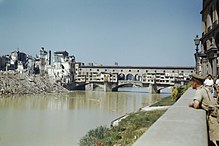
With the approach of Allied troops in the summer of 1944, the protection of the art and culture city of Florence was cleverly exploited by the German and Allied sides for their own propaganda purposes. Despite the supposed German announcements to declare Florence an open city and the order issued by Kesselring on June 27, 1944 to evacuate the city, numerous military offices and troops were still in the city. The intervention of Cardinal Elia Dalla Costa and the German consul in Florence, Gerhard Wolf, with the German authorities to clearly acknowledge the status of the open city, went unheard. On the contrary, the German side continued to destroy civil infrastructures such as railway systems, substations and telephone lines. Due to the unclear German position, the Allies for their part refused to recognize Florence as an open city. On 27 July 1944, was Committee of National Liberation of Resistance proclaim not to believe the German pronouncements regarding the open city. On July 30, 1944, on the orders of City Commandant Fuchs, a wide strip on both sides of the Arno was cleared, affecting about a third of the population. The next day all bridges over the Arno were closed and preparations were made to blow them up, with the exception of the Ponte Vecchio . The bridges were blown up on the night of August 3rd to 4th, 1944. Instead of the Ponte Vecchio, the Germans blew up the streets leading to the bridge on both banks. A few hours later, on August 4, 1944, British troops of the 8th Army reached the southern outskirts of Florence. In the days that followed, urban warfare with the Italian resistance developed in the German-held districts on the left bank of the Arno, while the Allies waited on the right bank of the river. On August 12th the first Allied units crossed the Arno. The fighting with the slowly withdrawing German troops lasted until the end of August.
In the nationwide referendum on June 2 and 3, 1946 on the future form of government in Italy, the Florentines voted against the preservation of the kingdom and for the Republic of Italy. From 1946 to 1950 a coalition of socialists and communists ruled the city. A rapid economic and social change and upswing took place. The years up to 1964 were marked by the Christian-social politician Giorgio La Pira, who was mayor from 1950 to 1956 and again from 1960 to 1964. The flood in Florence in 1966 damaged many art treasures and claimed 34 lives, although the exact details were kept under lock and key by the authorities for decades.
Culture
art
Florence has a great and important artistic heritage. Cimabue and Giotto , the "fathers" of Italian painting, lived in Florence, as did Arnolfo and Andrea Pisano . Other important pioneers in architecture and sculpture were Brunelleschi, Donatello and Masaccio, all of whom spent most of their artistic lives in Florence. The polymath Leonardo da Vinci is also considered one of the most outstanding thinkers and inventors of his time. He spent a large part of his life in the city.
The art of many painters and sculptors is exhibited in the numerous museums in Florence, which are sold out, especially in the summer months, or queues with long waiting times. The most famous museums are the Uffizi Gallery and the Palazzo Pitti , with an outstanding collection.
Language and dialect
Florentine (fiorentino) is spoken in Florence . Florentine is a Tuscan dialect that is identical to standard Italian in many parts , but has peculiarities in pronunciation .
Law
In 1786, with the abolition of the death penalty and torture by Peter Leopold (1765 to 1790 Grand Duke of Tuscany), these methods also ended in Florence.
religion
The population is about 99% Roman Catholic, due to the important seat of the Archbishop and the Episcopal Church of Santa Maria del Fiore . However, there are several churches of other Christian denominations as well as a synagogue.
Attractions
| Historic center of Florence | |
|---|---|
|
UNESCO world heritage |
|

|
|
| National territory: |
|
| Type: | Culture |
| Criteria : | (i) (ii) (iii) (iv) (vi) |
| Surface: | 505 ha |
| Buffer zone: | 10,480 ha |
| Reference No .: | 174bis |
| UNESCO region : | Europe and North America |
| History of enrollment | |
| Enrollment: | 1982 ( session 6 ) |
| Extension: | 2015 |
The historic old town of Florence reflects the outstanding achievements of the city in the field of architecture. In particular, countless buildings were built from the time of the Protenaissance to the rule of the Medici in the 15th and 16th centuries, which prove the enormous economic and cultural importance of the city at that time. The development of many of the city's buildings was supported by the city's bankers and merchants.
Florentine architecture is particularly characterized by the principles of Renaissance architecture formulated by Brunelleschi , Donatello and Masaccio at the beginning of the 15th century , which have gained importance far beyond the city. The historic old town of Florence was included in the UNESCO World Heritage List in 1982, whereby the application states that “any justification for this is ridiculous and unabashed”, since it is the “world's largest accumulation of universally known works of art”.
Squares, streets and bridges
Piazza della Signoria
The center of the historic old town is the Piazza della Signoria . Here the Florentines sent Dante into exile in 1301, here they burned jewelry, cosmetics, mirrors, musical instruments and the like in 1497 at the request of Girolamo Savonarola in the “purgatory of vanities” and in the following year, according to the papal judgment, Savonarola himself. Originally, Michelangelos was on the square Statue of David on the front of the Palazzo Vecchio . The statue has since been replaced by a copy, the original is in the Accademia di Belle Arti . Bartolomeo Ammanati's marble fountain of Neptune is also located on the square . It forms the end point of a still functional aqueduct from ancient times. Besides the Palazzo Vecchio, the Loggia dei Lanzi is located in this most important square in the city.
Piazza della Repubblica
The square with the triumphal arch is located on the site of the Roman center . It was planned when Florence was the Italian capital from 1865 and was designed in a historicist manner around 1890 .
Ponte Vecchio
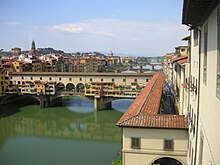
The only bridge that survived the Second World War unscathed is the Ponte Vecchio . The bridge, first built by the Etruscans , connects the Uffizi with the Medici Palace. Today it is characterized above all by the jewelry shops built along its two parapets , some of which protrude over the bridge.
Churches

The center of the Florentine churches is the Romanesque-Gothic cathedral of Santa Maria del Fiore with its impressive dome by Filippo Brunelleschi . The church, built from the 12th to the 14th centuries, is open to tourists. The cathedral complex also includes the Giotto campanile to the south of the cathedral and the Baptistery of San Giovanni with the gate of paradise to the west in front of the church . Important sculptures from the church such as the Pietà Palestrina by Michelangelo can be viewed in the Cathedral Museum.
The first version of the Basilica di San Lorenzo dates from 390 ( consecrated by Ambrose ) and was rebuilt by Brunelleschi from 1421 in the forms of the early Renaissance. Due to a lack of money in the meantime, the construction work was suspended several times. The execution of Brunelleschi's plans could only be completed after his death, but despite a spectacular design by Michelangelo from 1518 to this day, the facade has remained unfinished. The Medici Chapel joins the choir between the two sacristies of Brunelleschi and Michelangelo and , like these burials, houses the Medici family . On a cloister south of the church is the Biblioteca Medicea Laurenziana , also created according to plans by Michelangelo.
- Romanesque : Baptistery of San Giovanni (11th / 12th century), San Miniato al Monte (11th century), Santi Apostoli (11th century)
- Romanesque-Gothic: Badia Fiorentina (13th / 14th century), Orsanmichele (1337)
- Gothic : Santa Trinita , Santa Maria Novella , San Salvatore al Monte , Santa Croce (with tombs of Michelangelo , Galileo Galilei , Machiavelli , Gioachino Rossini , Ugo Foscolo )
- Renaissance : Santo Spirito , Santissima Annunziata
The Gothic church and monastery complex of Santa Maria Novella
The Franciscan Church of Santa Croce , built in 1294
Palaces
The Palazzo Pitti , opposite the Piazza della Signoria across the Arno, now houses the former private collection of the Medici. Connected to the palace is the Boboli Garden with impressive landscaping and many sculptures, behind it the Belvedere , which allows a view over the city.
Also worth mentioning among the medieval palaces are:
- Palazzo del Bargello (Palazzo del Podestà), now a museum of sculpture
- Palazzo Davanzati
- Palazzo Vecchio
Renaissance palaces worth seeing are:
- Palazzo Gherardi
- Palazzo Medici Riccardi
- Palazzo Rucellai
- Palazzo Bartolini Salimbeni
- Strozzi Palace
- Palazzo Pandolfini
Garden facade of the Pitti Palace
First secular building of the early Renaissance : Palazzo Medici Riccardi
Courtyard of the Strozzi Palace
Museums (selection)
- Uffizi Gallery
- The Uffizi next to the Piazza della Signoria, which was built under the rule of the Medici as an administrative building for the Grand Duchy of Tuscany, is home to one of the world's most important museums for classical art, especially Italian painting.
- Accademia
- The Art Museum Galleria dell'Accademia (Via Ricasoli 58/60) and the museum of the renowned Florentine restoration workshops Opificio delle Pietre Dure (Via degli Alfani 78) are subordinate to the Accademia di Belle Arti and are located in the same block on the Piazza delle Belle Arti .
- Museo Nazionale del Bargello
- The Palazzo del Bargello ( Palazzo del Podestà ) houses a museum with works of sculpture , including works by Donatello , Giambologna and Michelangelo as well as z. B. also works of painting like those of the not known by name, named after his work in the museum master of the Bargello-Tondo .
- Pitti Palace
- The Palazzo Pitti , on the other side of the Arno, houses the former private collection of the Medici, with an extensive collection from the Renaissance period, including paintings by Raphael .
- Museo dell'Opera di Duomo (Cathedral Museum)
- In the house of the former Dombauhütte an important sculpture collection with works by Michelangelo, Donatello and today. a. and to see numerous pieces of equipment of the cathedral, the campanile and the baptistery. After almost three years of construction and costs of almost fifty million euros, the new museum was opened in November 2015 under the direction of Timothy Verdon. By using the adjacent former Teatro degli Intrepidi (Theater of the Fearless), the exhibition area was expanded to 6000 square meters.
- Other museums
- The Museo Archeologico Nazionale (Archaeological Museum) and the Museo di Storia Naturale (Natural History Museum) are part of the university.

Gardens
- Boboli Gardens (Palazzo Pitti)
- Giardino Bardini , not far from the Boboli Gardens and Forte Belvedere
- Giardino delle Rose , below the Piazzale Michelangelo in a westerly direction in Viale Giuseppe Poggi
- Giardino dell'Iris , also near Piazzale Michelangelo, but only open to the public in May.
More Attractions
- Farmacia di Santa Maria Novella , the oldest pharmacy in Europe
- Biblioteca Medicea Laurenziana based on plans by Michelangelo next to the Basilica of San Lorenzo
- university
- Great Synagogue of Florence
- Santa Maria Maddalena dei Pazzi
- San Marco
- Villa Medici La Petraia
- Villa La Pietra
- Villa Gamberaia
- The Vasari Corridor connects the Palazzo Vecchio with the Palazzo Pitti
- Stone coat of arms on the Piazza della Signoria
economy
The main economic activity in Florence is tourism. In the summer months, the number of tourists is significantly higher than that of the Florentines. The city's major museums are regularly sold out.
Florence is home to the headquarters of the haute couture company Gucci , which makes it one of the few Italian fashion houses that is not based in Milan. Prada , Pucci , Ferragamo and Roberto Cavalli also operate important branches in Florence or the surrounding area .
In 2008, the city ranked 17th out of 119 Italian cities in terms of median income.
As a trading city, Florence benefits as the largest city in Tuscany and can thus accommodate an extensive wine trade .
In culinary terms, Florence is also known for the production of Cantuccini .
traffic
air traffic
In the northwest of Florence is the small international airport Amerigo Vespucci , which is served by Alitalia and Lufthansa , among others . Busses connect it to the center. In local transport, the airport is served by bus lines and a tram line that opened in 2019.
Street
Florence is on the E45 - A1 (Milan - Rome) and A11 (Pisa - Florence) motorways . There are also various expressways.
In addition, since 1928 Florence hub for state roads: the coming of Rome and ending SS2 , leading to Bologna SS65 , leading to Piteglio-La Lima SS66 and the city traversing SS67 Pisa Porto Corsini.
In the historic old town, outside cars and rental cars - with the exception of residents and public holidays - are strictly prohibited from entering ( zone with restricted traffic , zona a traffico limitato , or ZTL for short). At the entrances to the traffic zone, surveillance cameras - similar to London - use the license plate to check in real time whether or not an entry permit is available. Entrances without a permit are immediately punished with heavy fines.
railroad
The most important north-south railway connection in Italy from northern Italy to Rome and Naples ( high-speed line Bologna – Florence and Direttissima Florence – Rome ) and thus also the TEN axis No. 1 Berlin – Palermo runs through Florence . In addition to the Firenze SMN main train station , there are two other long-distance train stations in the city, Campo di Marte and Rifredi. It is also planned to build a new high-speed train station ( Firenze Belfiore ) in the medium term .
Local transport
The first line of the Florence tram connects the central station Firenze SMN with the neighboring city of Scandicci . It was put into operation on February 14, 2010 and has 14 stations over a length of 7.8 kilometers. Before it went into operation, the city was expecting around 9.8 million passengers a year. It is operated and serviced by RATP Dev , a branch of the operator of the Paris Metro RATP , as part of a concession awarded after a tender with a term of 30 years . Two more lines (line 2 and line 3) are currently (as of 2016) under construction.
Sports
Soccer
The football club AC Florence , Italian ACF Fiorentina, also simply called Fiorentina, is the largest football club in Florence. It was founded on August 29, 1926 by Luigi Rudolfi . The club won two Italian championships , most recently in 1969, the European Cup Winners' Cup in 1961 and the Italian Cup six times . The Fiorentina was the first Italian club in 1957 in the final of the European Cup . The home games are played in the Stadio Comunale Artemio Franchi , built in 1931 , where several games from the 1934 and 1990 World Championships were also held. A semifinal game was played there at the European Championship in 1968 .
Other football clubs in Florence are the Associazione Sportiva Dilettantistica Ponte Rondinella Marzocco , which played in Serie C in the 1980s , and Polisportiva Firenze Ovest ASD , which competed in regional amateur championships.
In Florence is the headquarters of the Italian Lega Italiana Calcio Professionistico, better known as Lega Pro, which holds the Serie C championship, the Coppa Italia Serie C, the Supercoppa di Serie C, the Campionato nazionale Dante Berretti and from 2018 the Supercoppa Dante Berretti organized by the third professional league of Italian football. Until 2014, the association also organized the Lega Pro Seconda Divisione and the Supercoppa di Lega di Seconda Divisione.
The national training and performance center of the Italian national football team is located in the Coverciano district . The Italian national team trains there in preparation for the official games of the World Championships and European Championships.
Calcio Storico
A special tradition is the Calcio Storico ( historical soccer ), also called Calcio Fiorentino, is an early hybrid of soccer, martial arts and rugby, which originated in Italy in the 16th century and is only played in Florence today. Once widespread, the sport is said to have started in Piazza Santa Croce in Florence. There it became known as giuoco del calcio fiorentino , the Florentine kick game. The game may have started as a revival of the Greco-Roman sport of harpaston .
Personalities
Famous personalities of the city are included in the list of personalities of the city of Florence .
Town twinning
Florence has partnerships with the following cities:
-
 Bethlehem , Palestine
Bethlehem , Palestine
-
 Budapest , Hungary
Budapest , Hungary
-
 Dresden , Germany
Dresden , Germany
-
 Edinburgh , Scotland
Edinburgh , Scotland
-
 Fes , Morocco
Fes , Morocco
-
 Isfahan , Iran
Isfahan , Iran
-
 Kassel , Germany
Kassel , Germany
-
 Kiev , Ukraine
Kiev , Ukraine
-
 Kuwait City , Kuwait
Kuwait City , Kuwait
-
 Kyoto , Japan
Kyoto , Japan
-
 Nanjing , China
Nanjing , China
-
 Nazareth , Israel
Nazareth , Israel
-
 Philadelphia , USA
Philadelphia , USA
-
 Heroica Puebla de Zaragoza , Mexico
Heroica Puebla de Zaragoza , Mexico
-
 Reims , France
Reims , France
-
 Riga , Latvia
Riga , Latvia
-
 Salvador (Bahia) , Brazil
Salvador (Bahia) , Brazil
-
 Sydney , Australia
Sydney , Australia
-
 Tirana , Albania
Tirana , Albania
-
 Turku , Finland
Turku , Finland
-
 Valladolid , Spain
Valladolid , Spain
music
- Souvenir de Florence , a string sextet by Peter Tchaikovsky , was written in 1890 after the composer spent several months in Florence.
Film productions
The following list shows a selection of films and series shot completely or partially in Florence:
- Paisà , 1946, 134 minutes, director: Roberto Rossellini
- Vitelloni (The Idlers) (Original title: I vitelloni ), 1953, 100 minutes, director: Federico Fellini
- Der Unverstandene (Original title: Incompreso ), 1966, 105 minutes, director: Luigi Comencini
- An insane class reunion (original title: Amici miei ), 1975, 140 minutes, directed by Mario Monicelli
- Black Angel (Original title: Obsession ), 1976, 95 minutes, director: Brian De Palma
- The Firestorm (Original Title: Winds of War ), TV series, 1983
- Zimmer mit Aussicht (Original title: A Room with a View ), 1985, 116 minutes, director: James Ivory
- Everyone's fine (original title: Stanno tutti bene ), 1990, 125 minutes, director: Giuseppe Tornatore
- Tea with Mussolini (original title: Tea with Mussolini ), 1999, 111 minutes, director: Franco Zeffirelli
- Hannibal , 2001, 131 minutes, directed by Ridley Scott
- The best years (original title: La meglio gioventù ), 2003, 366 minutes, director: Marco Tullio Giordana
- The Medici rulers of Florence (Original title: I Medici ), TV series, 2016
- Inferno , 2016, 122 minutes, directed by Ron Howard
Web links
|
Further content in the sister projects of Wikipedia:
|
||
|
|
Commons | - multimedia content |
|
|
Wiktionary | - Dictionary entries |
|
|
Wikiquote | - Quotes |
|
|
Wikivoyage | - Travel Guide |
- Internet presence of the city of Florence (Italian, English)
- Florence: Virtual travel in the city of Renaissance (Italian, English, Spanish)
- Entry on the UNESCO World Heritage Center website ( English and French ).
- Link catalog about Florence at curlie.org (formerly DMOZ )
Individual evidence
- ↑ Statistiche demografiche ISTAT. Monthly population statistics of the Istituto Nazionale di Statistica , as of December 31 of 2019.
- ↑ Carl Eduard Vehse: World history from the standpoint of culture and national characteristics. 41 lectures held in Dresden in the winter of 1841/42, Volume I, Walthersche Buchhandlung, Dresden, 1842, page 412
- ↑ Adolf Beer: On the progressive development of historical studies in the Kingdom of Naples from the second half of the 18th century to the present. In Heinrich von Sybel: Historical magazine, sixth volume. Cottasche Buchhandlung, Munich, 1861, page 326
- ↑ Leaves for literary entertainment, year 1853, first volume, January to June, containing no. 1–26, FA Brockhaus Verlag, Leipzig, page 159
- ^ Franz Grillparzer : Collected Works. Volume 5, RM Rohrer, 1949, page 327
- ↑ Euromonitor International City Ranking
- ↑ Forbes Magazine
- ↑ Vis a Vis, Florence & Tuscany: Palazzi, museums, ice cream, city maps, churches, Renaissance, cities, architecture, hotels, art, frescoes, beaches, shopping, Dorling Kindersley; Edition: updated edition 2009/2010. (September 2009)
- ↑ La Giunta comunale , on comune.fi.it
- ^ Klaus Voigt: Refuge on revocation. Exile in Italy 1933–1945 . Volume 1. Klett-Cotta, Stuttgart 1989, pp. 88 ff., ISBN 3-608-91487-0 .
- ^ Klaus Voigt: Refuge on revocation. Exile in Italy 1933–1945 . Volume 2. Klett-Cotta, Stuttgart 1993, p. 345 ff., ISBN 3-608-91160-X .
- ↑ Newspaper archive from 3.7.44
- ↑ Luca Moreno: Storia della Città di Firenze dal 59 aC al 2010. Bordighera, 2012 pp. 252-254
- ↑ Enzo Collotti: L'occupazione tedesca in Toscana. In: Marco Palla (ed.): Storia della Resistenza in Toscana. Volome primo. Carocci editore, Rome 2006 ISBN 88-430-3681-5 pp. 143-146
- ↑ David Tutaev: The Consul of Florence: The Salvation of a City. Econ, Düsseldorf-Vienna 1967
- ^ Matteo Mazzoni: Agosto 1944: la battaglia di Firenze. In: storiadifirenze.org. August 2014, accessed November 13, 2019 (Italian).
- ↑ Advisory Body Evaluation ICOMOS. (PDF; 166 kB)
- ↑ Michael Lingohr: The Florentine palace of the High Renaissance. The Palazzo Bartolini Salimbeni in its historical and architectural-historical context . Wernersche Verlagsgesellschaft, Worms 1997, ISBN 978-3-88462-137-0
- ↑ Overview of the average income in Italy ( Memento from May 12, 2011 in the Internet Archive )
- ↑ City of Florence: Pianta ZTL. Retrieved November 29, 2017 .
- ↑ a b c d lesechos.fr : La RATP met en service le tramway de Florence. Retrieved March 5, 2011 .
- ↑ Technical Center in Coverciano ( Memento of September 3, 2018 in the Internet Archive ) (Italian)
- ^ Calcio Storico in Florence - The bloodiest team game in the world at focus.de
- ↑ Gemellaggi, Patti di amicizia e di fratellanza. Comune di Firenze, accessed August 28, 2015 (Italian).
- ↑ Hízelgő a magyar fővárosnak: Firenze testvérvárosának fogadta. In: Népszabadság . May 17, 2008, Retrieved December 28, 2009 (Hungarian).



